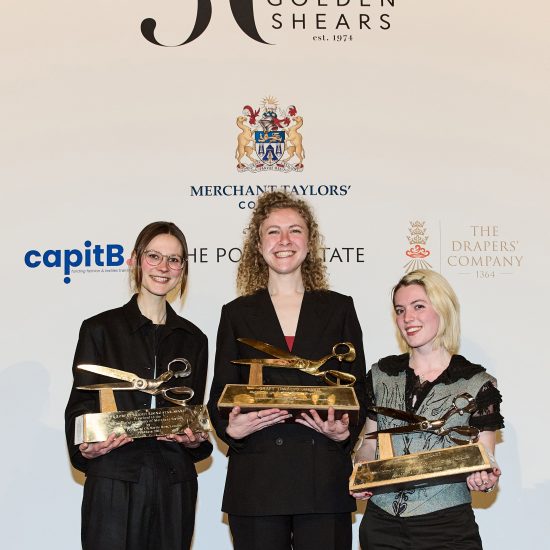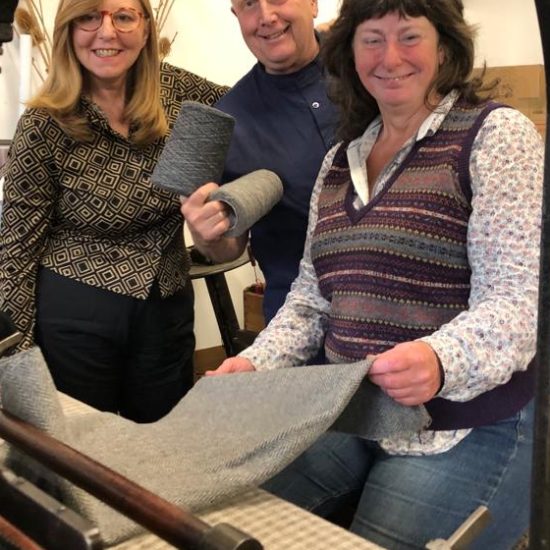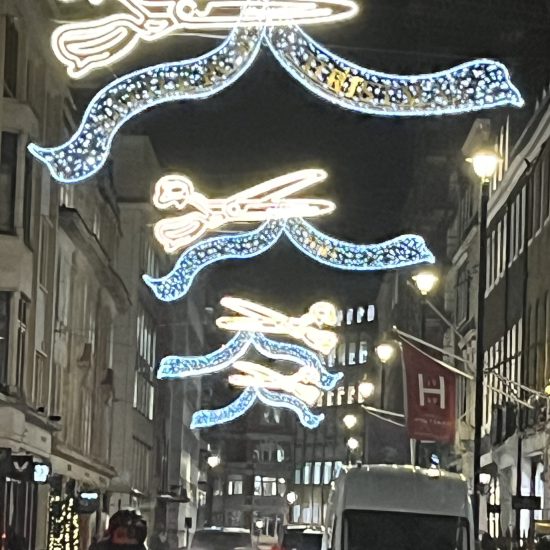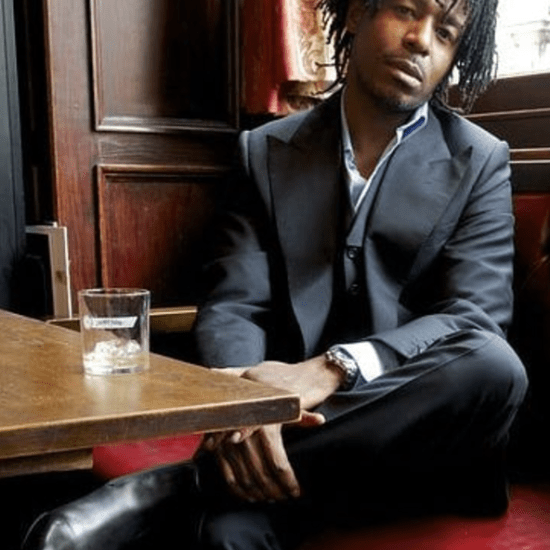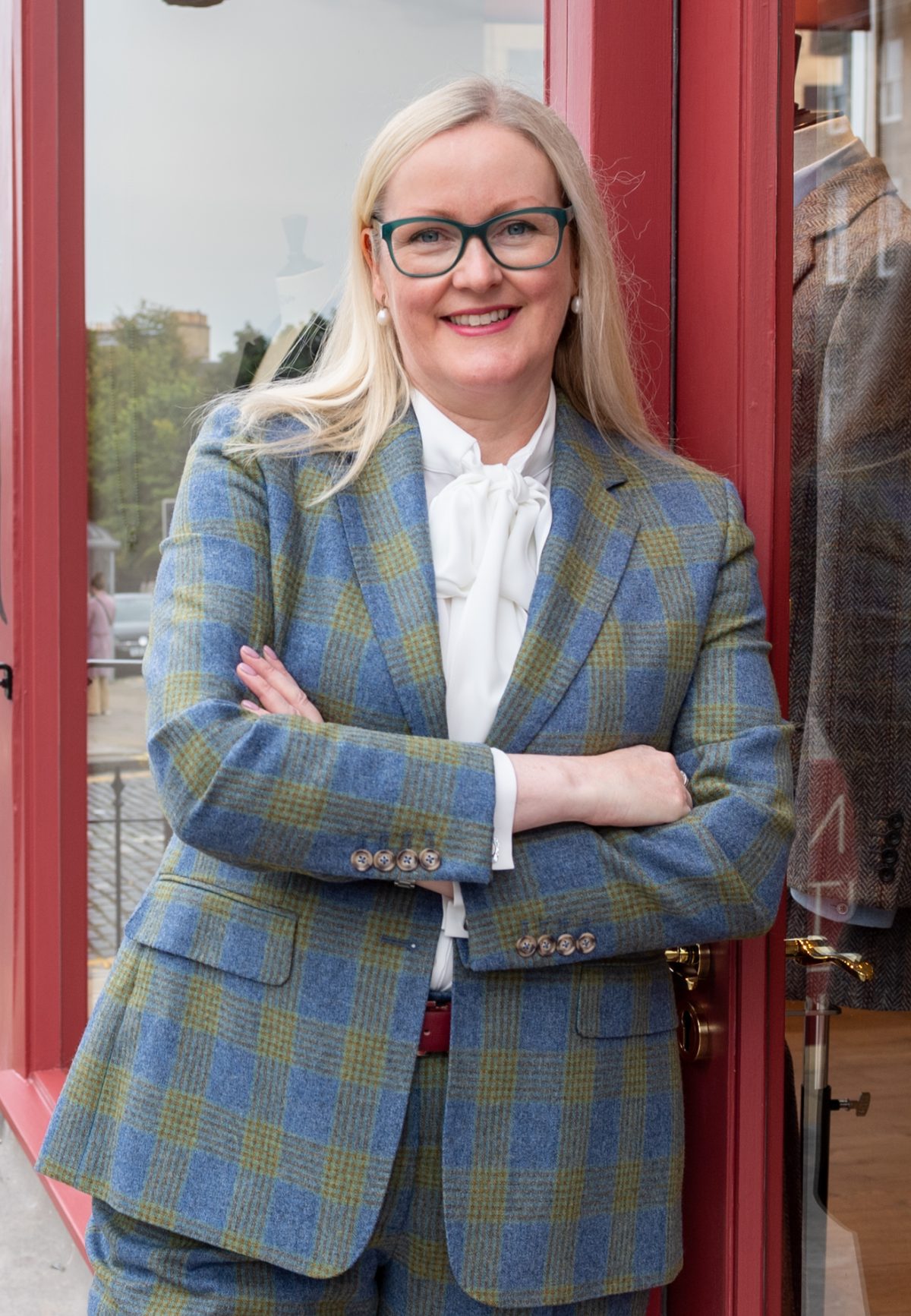
Kathryn outside her new Edinburgh atelier. Picture credit: Roberto Ricciuti
By Daniel Evans
It was no more than a three-minute walk – after all, Savile Row is barely 100 yards from end to end – but it was enough to change Kathryn Sargent’s life. It was during her time as a fashion student back in the 1990s that Kathryn, who grew up in Yorkshire and was then at college in Surrey, made the journey to Mayfair for the first time.
Kathryn takes up the story. “I was studying fashion at Epsom and was one of very few doing menswear. I was always interested in fashion when I was younger and one of my lecturers at college told me that if I wanted to learn more about tailoring, I should go to Savile Row and see tailoring where it’s really perfected, so that’s what I did. I went on my own to have a look and walked up and down. As I walked, I thought: ‘This is home’. I’d never seen anything like it. I was enchanted by the garments in the windows. I thought, yes, I want to make clothes like that. I didn’t understand how the business worked, I just thought I definitely wanted to do tailoring.”
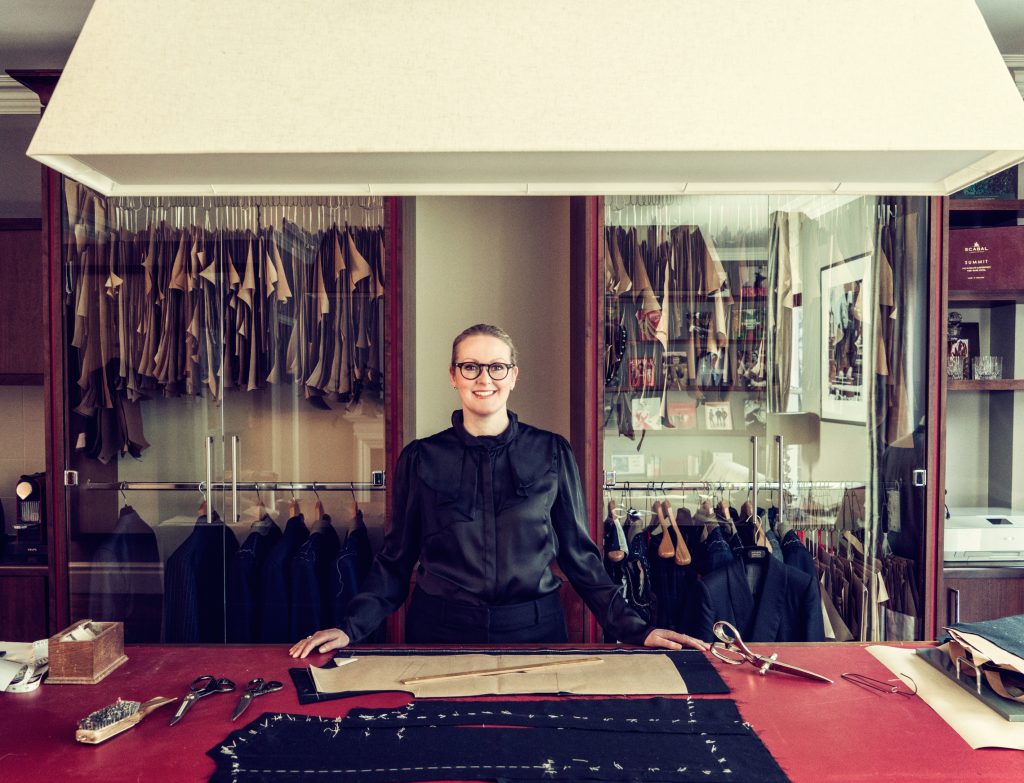
Kathryn in her Brook Street atelier
Today, some 30 years later, I am sitting across from Kathryn, now a master tailor and much admired throughout the industry, in her elegant work rooms in Brook Street, a stone’s throw from Savile Row, where she is telling me all about her journey – how she got to where she is and where she is going next – and, without wishing to give too much away, there is much ground to cover so let’s not dilly-dally and return to that student walk. “As I went up and down, I went into a few tailors and asked if there was a chance of some work experience,” Kathryn says. “Someone at Denman and Goddard who used to have a shop on New Burlington Street invited me in. They were fantastic and offered me some work which I loved. They had some really famous customers and seemed to have a great lifestyle and I just thought ‘wow – this is lovely. It’s not like proper work’.”
When she was a teenager, Kathryn was always interested in fashion. “I was inspired by my father who was never less than immaculately dressed,” she recalls. “He always wore a suit. I never saw him in jeans. And I loved James Bond. I was brought up on Bond. My favourite would have to be Sean Connery but I was probably brought up more on Roger Moore. Connery was in more of the classic Bond films but Roger Moore reminds me of my dad with the fashions of the Seventies.
“As a young woman, I just had this interest in menswear, which wasn’t very fashionable at the time. I was interested in the construction and patterns of making clothing but I didn’t really know how to do it so I had a lot to learn. I liked the power of a suit. I was curious about menswear and to see what putting a suit on can do for a man. Someone can wear something that makes them feel empowered and leaves a lasting impression on someone else.”
When Kathryn graduated, she did her final collection in Harris Tweed which was good enough to win an award and was singled out for a gala fashion show. “That was a major moment and led to me getting a job at Gieves and Hawkes in 1996,” she says. “I was taken on as an apprentice and I had to do a three-month probation on the shopfloor to understand the company and their customer before I was let anywhere near cloth. I was allowed to do one day a week in the work rooms where I watched and shadowed the tailors and the cutters.
“After three months I passed the probation and they took me on full time. I was taken on as a trimmer initially and I learnt how to make waistcoats. I worked with the tailors after hours and at weekends to learn with them. I then became a junior cutter to work alongside a cutter so my main day job was trimming and undercutting. I was eventually let into the fitting room to watch fittings so I was an assistant in the fitting rooms as well as doing the other jobs. I became a proper undercutter so would go into the fittings but only spoke when I was spoken to. I’d just watch and help when required.”
By the late Nineties, Kathryn had been an undercutter for four years when Gieves needed someone to work on Saturdays. As none of the three cutters there at the time wanted to work at the weekend, Kathryn grabbed her chance. “I measured my first customer on a Saturday and it built up from there,” she says. “Gieves weren’t too sure about letting me do it but I’d seen it be done so many times it all worked out. I progressed to become more of a cutter doing everything. It wasn’t a plan when I started there but it kind of evolved. I knew I wanted to see customers and I wanted to do fittings.
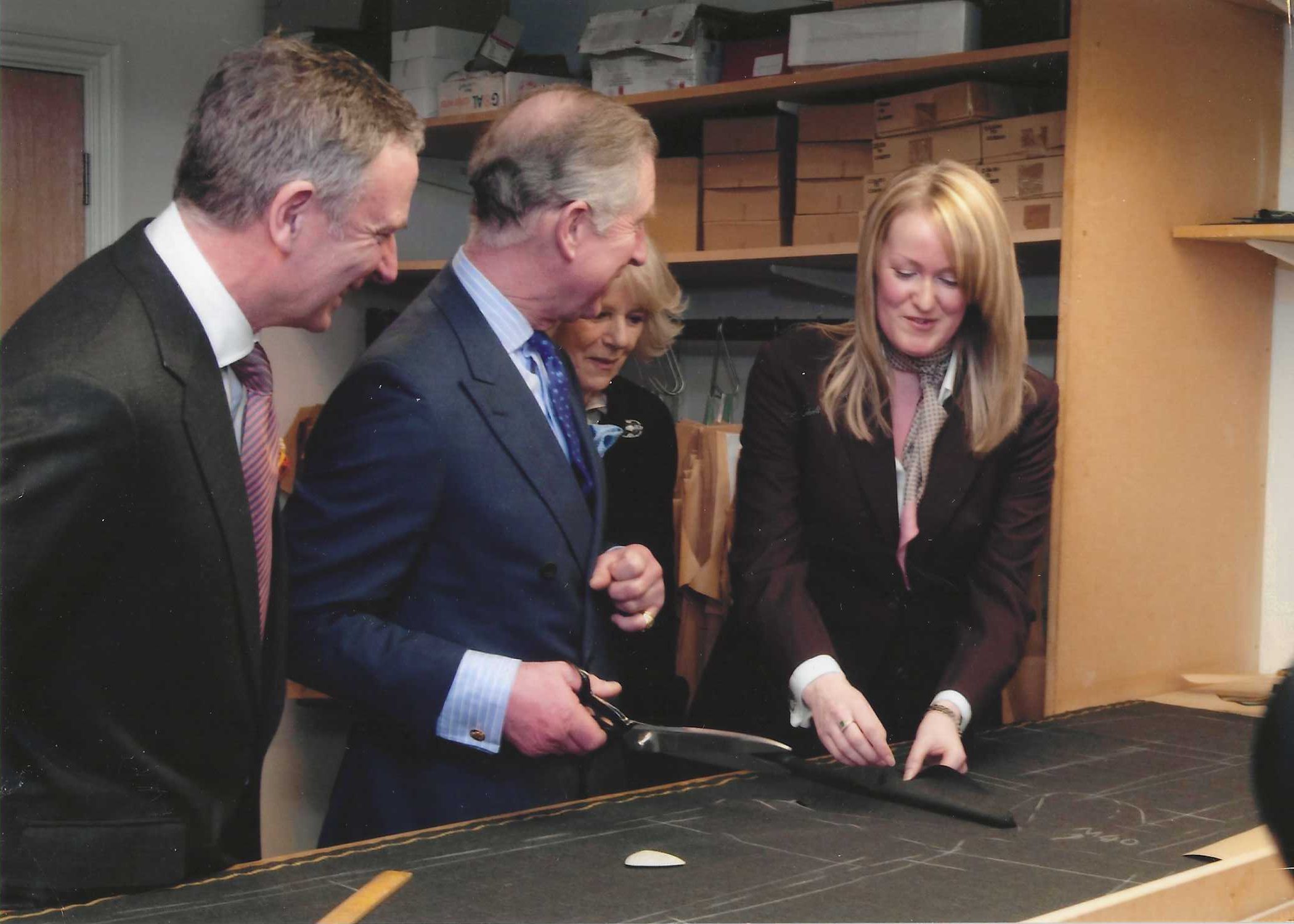
The then Prince Charles and Camilla meet Kathryn on a visit the couple made to Gieves & Hawkes to celebrate many years of holding the royal warrant
“We had some female customers – one the wife of an existing client who wanted a suit made. We made the suit and sent it to Chicago but, for some reason, it didn’t arrive. The client went mad and my boss decided we should go to Chicago and sort this out. Because we were going to America, we contacted some other previous clients, some in New York, and we ended up taking a lot of orders. Then we started going back to see customers in America and I used to go out three times a year, representing Gieves and taking orders, and I’ve been doing that ever since but now I go for my own company.”
In 2009, Kathryn moved up to become head cutter at Gieves, the first time a woman had been a head cutter on Savile Row. As she says: “It was part of my career but also a mark of all the hard work I had put in to get there.”
It was around this time that something rather surprising happened. Most people who rise to the heights of head cutter at one of the most prestigious tailoring houses in the world would be happy with their lot and stick around, to be surrounded by fabulous garments, work with talented people and enjoy the admiration of colleagues and rivals.
But not Kathryn. She wanted something more.
“To be honest, when I started at Gieves, I never thought I would leave,” she says. “I thought I’d do the long service and get the carriage clock. I did know other head cutters on Savile Row but they were not managing the business and that’s what I wanted to do. At one point, I was asked to put together a plan to develop women’s bespoke at Gieves so I did and presented it to the board. They thought it was great but decided to concentrate on menswear but the whole project had got me thinking.
“At Gieves, we were getting more and more women wanting amazing clothing and I thought there’s an opportunity here – I can do this. And the idea of working for one company for ever wasn’t for me. I felt I might have become stilted. I knew other people in other businesses who were frustrated and I could see that, potentially, I would become frustrated and I didn’t want that to happen. I could see that Gieves were going in the direction of creating a brand look – a real, solid brand look – but I like the variety of bespoke. I think the art of bespoke tailoring is to work with the individual and I wanted to go back to true bespoke tailoring. I wanted to set up a business based on those true values. I thought there’s an opportunity here for a business that’s fresh, inclusive. One that can target women but also create lovely garments for men and I can do it in my way.”
So, fired with enthusiasm, Kathryn went on a two-week business course, wrote a business plan and decided to give it a go. She recalls: “I handed in my resignation to Gieves. I was sad to leave but I knew I could do something else. I left at the end of 2011 and started my business early in 2012. At the beginning, I rented space on Sackville Street. I was there for a couple of years, and I saved up some money to get a deposit on my own place. I found this space on Brook Street and we’re still here.”
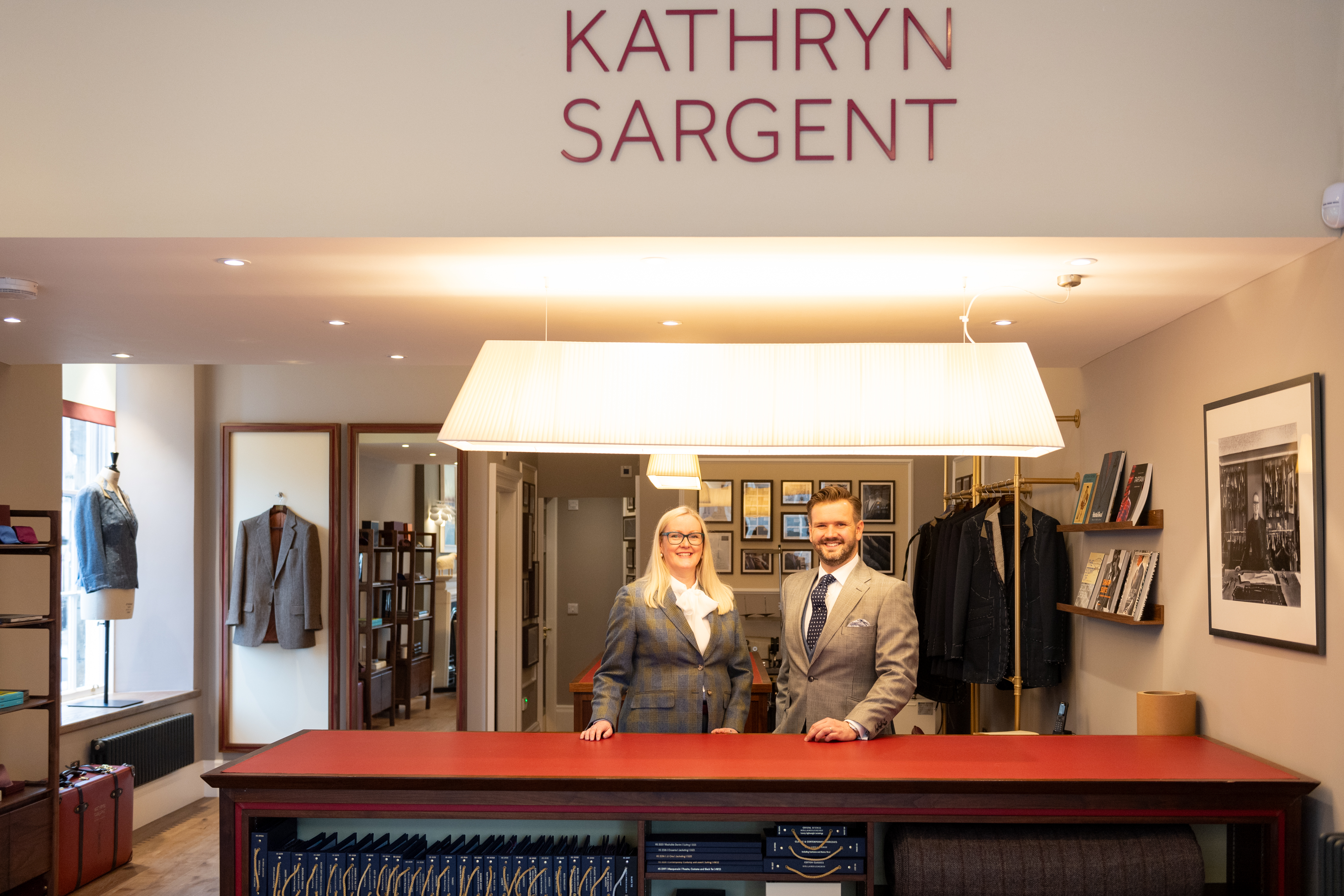
Kathryn in her new Edinburgh atelier with Alistair Nimmo. Picture: Roberto Ricciuti
More than 10 years on from setting up on her own, Kathryn is still loving life. “It’s the customers and the people I like the most,” she says. “It’s lovely to work with individuals and get to know them. I didn’t want to be a designer designing for an imaginary customer. I like to know the individual and get to understand what they want – to create something special for them. We’re all different personalities, body shapes and it’s using your skillset to produce something that’s unique for the individual. That’s what I love about it – the variety. I wouldn’t be happy cutting the same thing all the time. The beauty of bespoke is the art and craft of it. We are making things that will last and people will wear time and time again. I want to make it hard for people to go elsewhere once they’ve come to us. We are getting women come in who are frustrated they can’t find clothes to fit them. As a woman, it can be a joy to discover that you can have something that actually fits you.”
One project taking a lot of Kathryn’s time at the moment is her decision to open a new store up on Howe Street in Edinburgh. She explains: “As well as wanting to extend Savile Row tailoring to Scottish clientele, we noticed a number of our existing clients, particularly from USA and Europe, were travelling through Scotland on business and leisure trips and requesting tailored outfits and fittings for their trips, so bringing Kathryn Sargent Bespoke Tailoring to Scotland is the next natural step for the brand. The new Edinburgh shop will blend traditional Scottish textiles and dress with the unique craft of Kathryn Sargent to create sustainable luxury garments. It’s all very new but it’s going well. We’re building relationships up there and I’m hoping it will be a great success.”
The shop will be under the day-to-day guidance of Alistair Nimmo, Head Cutter. Alistair trained with Kathryn over a number of years, holds a Savile Row Bespoke Diploma, and was born in Stirling. He said: “I’m proud to be heading up the Scottish arm of the business, it’s a natural fit with my personal heritage and professional passion for Scottish dress, deep knowledge of tartans, tweeds and ceremonial dress. Whether people want traditional Hogmanay dress or something more renegade in tartan, we can make it.”
Kathryn is also very involved with the Savile Row Bespoke Association where she is a board member. “The SRBA works hard to encourage young people into the trade and to promote and protect Savile Row. We set it up to protect the work rooms and deal with the issues we all share as a collective endeavour. Having a voice and seat at the table about something I really believe in is important to me. I have my own business which is great and I’m doing my own thing in that respect but I’m part of something much bigger. It’s important to work with my colleagues to promote and protect Savile Row with a collective voice.
Another project Kathryn is keen to promote is the Women in Tailoring network which began life during the summer. “The aim is to bring women in our industry in London – not just Savile Row – together,” explains Kathryn. “It’s hard to build a network if you are a young apprentice – to build a friendship network of people involved in the business. Lindsay Taylor from Holland and Sherry is chair, with Su Thomas as vice chair. We’ve had a couple of social gatherings. We’ve had a lot of interest nationally and I think it could potentially be a global network.”
Looking to the future, Kathryn is cautiously optimistic. “I do think Savile Row is going through an evolution,” she says. “I think you’ll find that the pure, bespoke tailoring might become less and there will be more made to measure. We’ve got to keep training; we’ve got to keep building. I don’t think tailors are going to suddenly disappear from Savile Row. It’s still an area which is hugely important historically to the nation and the craft. There has always been a global customer since I’ve been involved. It’s one of those bucket list things – a Savile Row suit. There’s always going to be a customer who wants to have that experience. Yes, I am optimistic. Some of those businesses have existed since the late 1700s and, as long as they are in good hands, they should have a positive future.”
Some 30 years on from that walk down Savile Row, Kathryn has every right to look back with a huge deal of pride and satisfaction. “I chose the profession of tailoring because I was fascinated by it,” she says. “I wanted to do something meaningful and creative. There has been a real sea change in the value of skills and tailoring is a much more valued profession today. I’ve enjoyed what has happened and I’m excited about what’s to come. Growing my business, here and in Scotland, growing my team, training is important. I’d like to grow the business but not be a brand that is everywhere. I still want to keep quality and craftsmanship. And I love having that complete control and autonomy over what I do. When you set up a business, you don’t really know what’s to come but, in my short business life, I’ve dealt with a lot of issues which have made me stronger and more capable of dealing with anything. I’m not worried about any problems, whatever they may be.”



